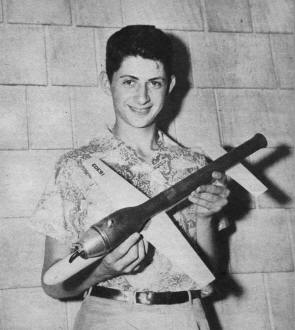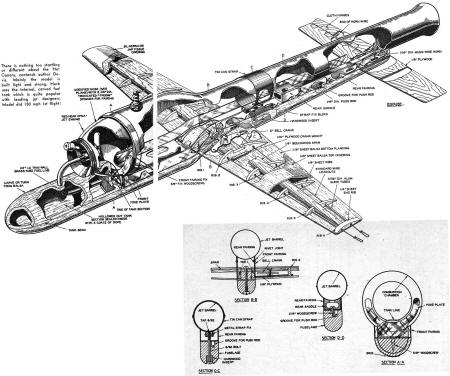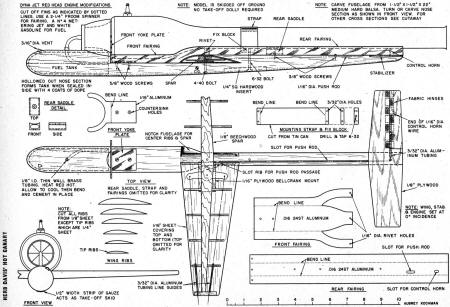|
Dyna-Jet pulse jet engines were a big deal in
the 1950s and 60s in part because it was the era when full-size jet aircraft were coming onto the
scene in military and commercial applications. They fulfilled the need for speed that many modelers
have. The Hot Canary set a record of 157 mph which, of course, has been far exceeded since then. In
fact, both pulse jet and internal combustion reciprocating engines have set control line records of
well over 200 mph.
Herb Davis' Hot Canary
Top honors at Dallas ...
First place at Detroit ...
National jet speed record job ...
Here is a Dyna-Jet speedster that flew 150 mph on its first hop! With much pride "AT" presents ...
Herb Davis' Hot Canary

A real "hot" contender in the speed circles is 17-year-old Herbert Davis of Birmingham,
Ala. Herb is a senior at the Shades Valley school who became interested in modeling 4 years ago. He
was high-point Junior winner at the '49 Detroit Plymouth International meet and captured top Senior
honors there in '51. Also in '51 he captured the "AT" Kulick Memorial Trophy. at Dallas in Class D speed
flying (more on that later!)
The Hot Canary is, as the name implies, a hot, fast ship. It is painted yellow, built small and light.
The total weight with Dyna-Jet engine comes to a modest 20 ounces.
My experience with jets has taught me to build them light. I do not mean to go to extremes and mount
the tube on a wing and stab, but keep the weight down and at the same time have a good strong ship.
The Hot Canary is strong and can take a beating as well as the next one.
This ship gave me a first place senior at the Dallas Nationals at a speed of 142.63 miles per· hour,
and a first at the Detroit Internationals at a speed of 144.29 miles per hour.
At the Peach State Model Meet in Macon, Ga., this year it racked up 157.43 miles per hour official
for a new national speed record.
It was test flown in Birmingham at 150 miles per hour on the first flight. The difference in speed
is, in my opinion, due to the difference in air temperatures prevalent at the various locations.
The ship is built as follows: The fuselage is made from a piece of 1 1/2" x 1 1/2" x 22" medium hard
balsa. The nose may be turned on a lathe for perfect roundness, although it can be carved with the use
of a template. After shaping the nose, bandsaw the rest of the fuselage to outline. The bottom of body
is carved round and sanded smooth.
The fuel tank is a result of trying many types. It will get you off under most weather conditions
and provide the required laps for the clocking.
The tank is made by hollowing out nose to 1/8" thickness on all sides. First the nose must be split
open and then hollowed out carefully. The inside of the tank is coated with 4 coats of clear dope or
until all pores are filled.
Now drill holes for tubing and glue in front vent. The fuel line is not easy to bend, so I recommend
heating a piece of 1/8" I.D. thin wall brass tubing until it becomes red hot; let it cool and then bend
it to shape and glue it in the tank. Fasten tank halves together with plenty of glue.

There is nothing too startling or different about the Hot Canary, contends author
Davis. Mainly the model is built light and strong. Herb uses the internal, carved fuel tank which is
quite. popular with leading jet designers. Model did 150 mph 1st flight!
The wing is of built-up construction using 1/8" ribs covered with 1/16" planking and a 1/8" beech
spar. First cut out bottom planking to outline on plans, then glue ribs in place. Now cut spar and lay
across ribs, mark and cut slots in ribs for spar to be glued in. Bellcrank can now be installed with
pushrod and lead-outs. Put on top covering at this point.
Wing is now ready to install. Cut 3/16" x 1/2" x 3 1/2" notches in the fuselage for wing and notch
for spar. Bolt spar to fuselage with 4-40 bolt. Don't forget groove for pushrod. When gluing wing in
make sure no glue gets near top of body, because glue tends to burn from the heat of the engine, causing
very undesirable results.
The stabilizer is made from 1/8" plywood. The horn is 1/16" music wire which runs through a piece
of 3/32" aluminum tubing.
Stab is slotted so horn works freely. Airfoil is symmetrical and should be mounted at 0 degrees incidence,
with wing and engine.
The metal fairing is made from .016 24 ST aluminum. The rear fairing should be bent on a "brake"
for a perfect fit. If you do not have one; it can be done at a sheet metal works. Front fairing can
be cut from pattern and bent to shape.
Rear saddle and front yoke can be put on after fairing parts are installed. Asbestos paper should
be put in from back of front yoke to front of rear saddle which is held in with water glass.
All metal fittings should now be removed for painting. The wings are first covered with Silkspan
or Jap tissue. Glue a 1/2" ,strip of gauze to bottom for a skid. Top of fuselage should be covered carefully
with masking tape. Now apply four coats of a mixture of equal parts of talcum powder and clear dope,
sanding between each coat. Apply three coats of yellow dope, rubbing last coat with rubbing compound
and then waxing.
The model is skidded off the ground instead of a dolly take-off. White gasoline is used for fuel
with a, No.4 metering jet.
Once considered a madman's event, model jet speed flying now is practiced throughout the world. With
the Hot Canary we feel sure you'll get off to an easy, successful start.

Hot Canary Assembly Drawing

Hot Canary Plans
Posted October 8, 2016
|